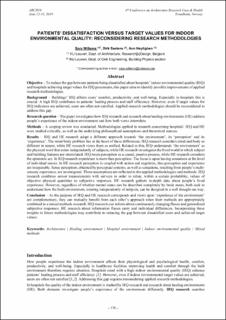| dc.description.abstract | Objective – To reduce the gap between patients being dissatisfied about hospitals’ indoor environmental quality (IEQ) and hospitals achieving target values for IEQ parameters, this paper aims to identify possible improvements of applied research methodologies.
Background – Buildings’ IEQ affects users’ comfort, productivity, and well-being. Especially in hospitals this is crucial. A high IEQ contributes to patients’ healing process and staff efficiency. However, even if target values for IEQ indicators are achieved, users are often not satisfied. Applied research methodologies should be reconsidered to address this gap.
Research question – The paper investigates how IEQ research and research about healing environments (HE) address people’s experience of the indoor environment and how both views interrelate.
Methods – A scoping review was conducted. Methodologies applied in research concerning hospitals’ IEQ and HE were studied critically, as well as the underlying philosophical assumptions and theoretical stances.
Results – IEQ and HE research adopt a different approach towards ‘the environment’, its ‘perception‘ and its ‘experience’. The mind-body problem lies at the heart of these differences. IEQ research considers mind and body as different in nature, while HE research views them as unified. Related to this, IEQ understands ‘the environment’ as the physical word that exists independently of subjects, while HE research investigates the lived world in which subject and building features are interrelated. IEQ treats perception as a causal, passive process, while HE research considers the epistemic act. In IEQ research experience is more than perception. The focus is upon having sensations at the level of individual senses. In HE research perception is coupled with action and cognition, thus perception and experience are inseparable. Sense perception, obtained by perceptual systems, as well as sensations, resulting from people’s multisensory experience, are investigated. These assumptions are reflected in the applied methodologies and methods. IEQ research combines sensor measurements with surveys in order to relate, within a certain probability, values of objective physical quantities to subjective responses. HE research gathers in-depth data about people’s lived experience. However, regardless of whether mental states can be described completely by brain states, both seek to understand how the built environment, existing independently of subjects, can be designed in a well thought out way.
Conclusion – As the purpose of IEQ and HE research corresponds and views upon ‘experience of the environment’ are complementary, they can mutually benefit from each other’s approach when their methods are appropriately combined in a mixed methods research. IEQ research can inform about continuously changing fluxes and generalized subjective responses, HE research about information fluxes carry and individual differences. Incorporating these insights in future methodologies may contribute to reducing the gap between dissatisfied users and achieved target values. | |

